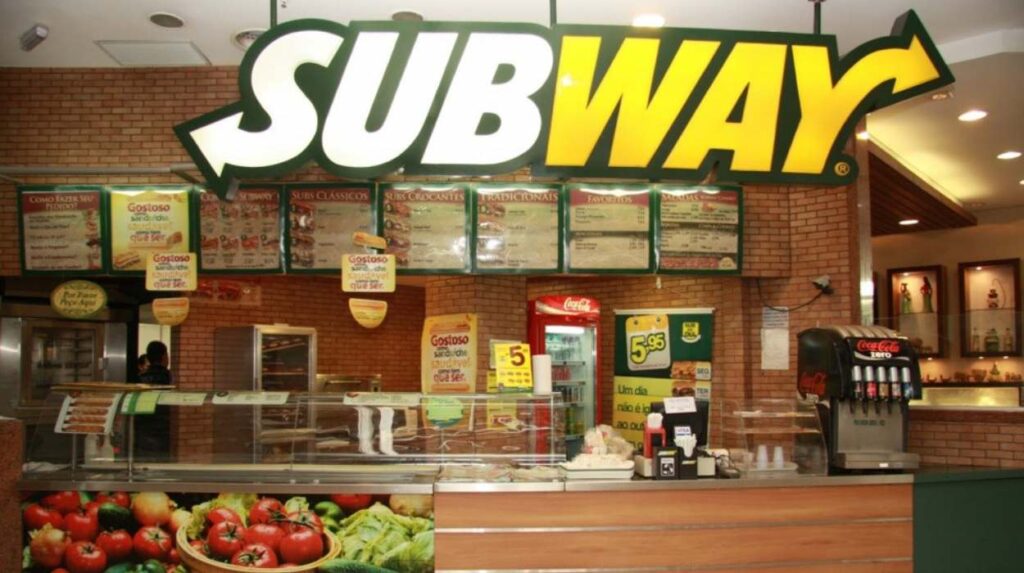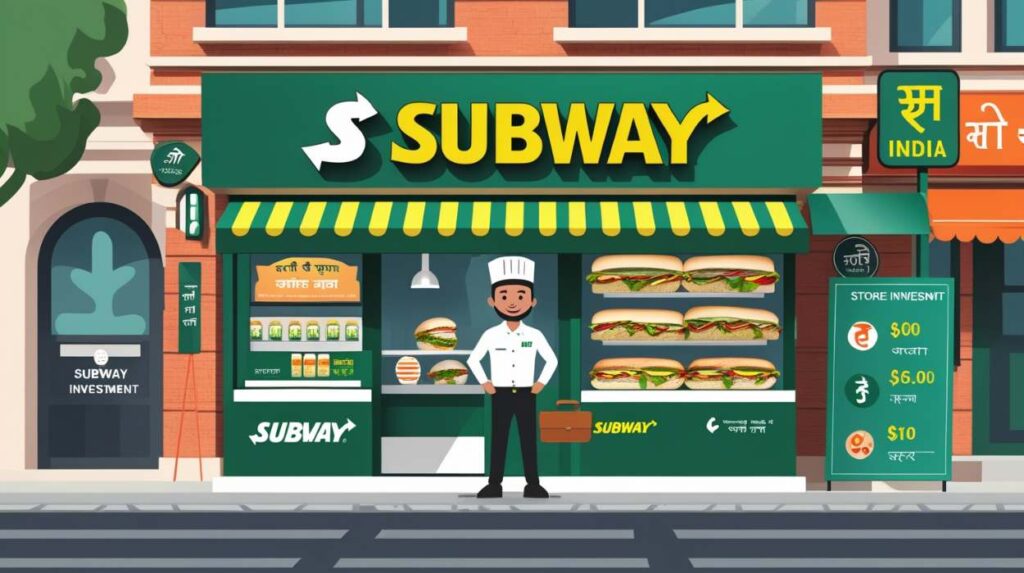Subway is among the fastest-growing chains of fast-food restaurants in the world and a very profitable franchise to dream of in India. Subway Franchise Cost in India typically ranges from INR 1.5 crore to INR 3 crore, allowing partners to acquire a well-known brand with more than 37,000 units spread all over the world. The franchise model focuses on the use of fresh ingredients, tailor-made sandwiches, and more nutritious options in comparison with conventional fast food.
The health-conscious strategy of Subway in the fast-developing Indian urban market is a perfect match with the tendencies of consumers who look towards healthier and quicker food. The franchise system is based on a royalty fee of 8% per month, with 4% allocated to marketing contributions, which ensures consistent brand support and marketing activity. Subway has a proven business model with detailed training, operation procedures, and continuous marketing assistance, which has continued to bring success in various markets all over the world.
Subway: History & Legacy, USP

Subway was started in 1965 by two men, Fred DeLuca and Peter Buck, in Bridgeport, Connecticut, as a small sandwich shop which, over the course of time, has grown into a global phenomenon. The history of this brand is based on the radical idea of the personalized approach to customers and their meal choice, as the brand offers an opportunity to create one and develop it based on the specific needs. Subway’s Unique Selling Proposition is focused on three pillars, which are the use of fresh ingredients, which are kept on daily basis, full customization of the meals, and healthier fast-food alternatives. Its high standards of ingredients, as well as open nutritional facts, also show that the brand prioritizes quality.
The innovative feature of Subway is its availability of different diets, such as vegetarian, vegan, gluten-free, and others to satisfy the needs of different customers. The engagement and the trust are achieved through the interactive dining experience as customers observe how their sandwiches are prepared. This focus on the customer, coupled with the consistency of quality and international recognition as a brand, has made Subway a leader in the quick-service restaurant business and as such, it makes it an interesting investment franchise.
Why Choose a Subway Franchise in India?
- Growing Market Demand: India’s urban population increasingly requires convenient, healthy eating options, providing enormous opportunities to price health-conscious food outlets.
- Proven Business Model: Subway brings forth a franchise system that has been tried and tested because of its global success in the past few decades, equipped with operational standards, a marketing mix, and a profitability framework.
- Health-Conscious Positioning: As most consumers large proportion inclined towards health and wellness, Subway with fresh ingredients and numerous options for healthy meals that suit their lifestyles.
- Strong Brand Recognition: The vast global presence of Subway conversations innate customer trust with goodwill, thereby reducing marketing and customer acquisition expenses.
- All-Round Support Systems: Franchisees enjoy training on all aspects, operations support, national marketing campaigns, and continuous support for business development.
- Investment Options: Investment options vary, making it easy to choose among outlets of different formats and locations according to the scale of investment and the choice of market positioning strategy.
Types of Subway Outlets
Mall and Shopping Center Locations
- High foot traffic areas with excellent visibility
- Target customers include shoppers, families, and entertainment seekers
- Higher sales volumes during weekends and holiday seasons
- Premium rental costs but potentially higher revenue generation
Business District Outlets
- Strategic positioning near corporate offices and commercial complexes
- Primary customer base consists of working professionals seeking quick, healthy lunch options
- Consistent weekday traffic with peak hours during lunch periods
- Focus on efficiency and speed of service for time-conscious customers
Educational Institution Proximity
- Located near colleges, universities, and educational hubs
- Target demographic includes students and academic staff
- Affordable pricing strategies with student-friendly promotions
- Steady customer base throughout academic years
Standalone Street-Front Locations
- Independent outlets with dedicated parking and easy accessibility
- Serve local neighborhood communities and residential areas
- Lower rental costs compared to mall locations
- Greater operational control and flexibility in service offerings
Food Court Establishments
- Positioned within larger food court complexes
- Shared customer traffic with other food vendors
- Compact operational space requiring efficient layout design
- Competitive environment demanding unique value propositions
What is the Subway Franchise Cost in India?
If you’re considering entering the fast-food business in India, you might ask, “What is the Subway Franchise Cost in India?” This question is crucial for aspiring entrepreneurs looking to capitalize on the growing fast-food market. The Subway franchise presents a unique opportunity with a strong brand presence, a loyal customer base, and a focus on healthier eating. In this comprehensive guide, we’ll dive into the franchise costs, ongoing expenses, strategies for success, reasons for Subway’s popularity, and much more.
Initial Franchise Fees
To kickstart your Subway franchise in India, you must pay an initial franchise fee, which typically ranges from between 6.5 lakhs to 10 lakhs. This fee varies based on the location and size of the outlet. The initial investment covers essential costs, such as:
- Equipment and Fixtures: The equipment package ranges between 8-15 lakhs and must-have items. This includes kitchen appliances, signage, and furniture required for your outlet.
- The cost of store setup and interior decoration varies between 5-12 lakhs.
- The starting stock and inventory investment will be of 2-4 lakhs.
- It is suggested that a working capital reserve of 3-6 lakhs would be sufficient.
- Legal and administrative expenses are estimated at 50, 000-1 lakh
- Training Costs: As mentioned earlier, comprehensive training is part of the initial investment.
- Franchise Documentation: Legal fees and documentation costs are also included in this amount.
The overall Subway Franchise Cost in India to establish a store in India would above 1.5 crore.
Ongoing Costs
Royalty and Marketing Fees
- Royalty fee monthly: 8% – 12% of gross sales revenue
- National advertising fund contribution: 4 percent of monthly sales
- Local advertisement and marketing campaign costs
- Costs of digital marketing and social media management
Operational Expenses
- Cost of Goods Sold (COGS): 30-35 percent of gross sales
- Provision of fresh ingredients and supply chain management
- Costs of replacing and maintaining kitchen equipment
- Utility costs such as electricity, water, and gas consumption
Staffing and Human Resources
- Salaries of employees, 10-15 workers, sandwich artists
- Management remuneration and benefits
- Training of new employees and skill development training programs
- Adherence to labor laws and statutory provisions
Facility and Infrastructure Costs
- Rental payments for the property by the month change depending on the area and the size of the property
- Maintenance of property, repair, and facility maintenance
- Property, equipment, and liability insurance payments
- Spending on technology, which involves POS systems, the internet, and communications services
Regulatory and Administrative Expenses
- Regulatory and administrative costs
- Regulations and regulatory fees, such as business license renewals
- Health department inspection and food safety certifications
- Charges of accounting, legal, and professional services
- Bank charges, credit card processing fees,sand financial services charges
How to Buy a Subway Franchise in India? Step by Step Guide

How to Get a Subway Franchise in India
Application Submission Process: The application process starts with the online application via Subway India site official franchise enquiry form, initial screening, financial verification, and participation in the Discovery Day. The successful candidates are supplied with franchise contracts to be executed legally, finance is secured, training is undertaken, an outlet is set u,p and the launch process is commenced.
Eligibility Criteria: Potential franchisees should be able to prove their financial strength through liquidity of 1.5-3 crore and be able to manage a business or show eagerness to train and be actively involved in the daily business. Prospective franchisees are expected to be strong leaders, customer-oriented, and share the same beliefs about the brand and the working principles of Subway.
Documentation Required: The following are required documents: financial statements, bank statement, income tax returns, business registration certificate, personal identification certificate, and property ownership or tenancy agreement. Other documentation could have business references, a credit report, a comprehensive business plan, which explains the plan of operation, analysis of the market, and financial projection.
Location Requirements: Subway considers locations depending on the traffic of the feet, visibility, accessibility, parking space and demographic fit. The most preferred sites are busy areas in malls, business centers, learning institutions and the busy commercial streets. The company has guidelines on the approval of location and undertakes site assessment prior to final approval.
Traditional Stores:
- Usable space: minimum 800-1200 square feet
- Preference of ground or first floor locations.
- High visibility good street frontage.
Non-Traditional Formats:
- 600-3000 square feet food court outlets and kiosks.
- Mall, airport, hospital, university or corporate office locations.
- Captive audiences and high footfall locations
Parking area of at least 10-15 cars (when it comes to traditional stores)
Subway Franchise Contact Number India and Important Links: All interested persons can communicate with the India franchise development team of Subway using the available official channels. To know more about the Subway India franchise, the application forms and contact details, visit the Subway India website. The development managers of regional franchises will offer consultation and guidance on a personal basis through the application process.
Profit and ROI: Analyzing Financial Availability
Potential investors often seek insights into profit margins and return on investment (ROI). A well-managed Subway franchise in a high-traffic area can yield a profit margin of 15-20%. To effectively calculate ROI, you need to consider the following:
Initial Investment vs. Earnings
Understanding your upfront investment compared to projected earnings over a specified period is essential for evaluating financial viability. Conduct thorough market research and financial assessments to develop realistic profitability estimates.
Location Impact
The location of your Subway franchise significantly influences its profitability. High-traffic areas, such as malls or business districts, can lead to higher sales volumes, making location selection a critical factor in your investment strategy.
Operational Efficiency
Efficient management of operational costs, including labor, inventory, and utilities, plays a crucial role in enhancing profitability. Implementing cost-control measures can help improve your bottom line.
Ongoing Support & Training Programs
- Extensive Training Comprises First Weeks: New establishments go through an intensive 2-week training comprising operational procedures, food safety protocol, customer service standards, and business management fundamentals.
- Operational Support: On an everyday basis, support staff provides assistance in operations, inventory management, quality control, and operational challenge troubleshooting.
- Marketing and Promotional Support: Provide your franchise with its marketing voice through national ad campaigns, local marketing materials, and a plethora of social media resources, including support for promotional strategies.
- Technology and Systems Support: Provide franchisees with constant training and help on front-end point-of-sale systems, vendor inventory tracking, and consumer digital ordering platforms to ensure smooth operations.
- Quality Assurance Programs: Conduct regular audits for quality, inspections for food safety, and monitoring of compliance concerning brand standards and operational excellence.
- Business Development Assistance: Analyzing performance, maximizing profits, updating menus, and assisting in entering new markets for best profitability and growth potential.
Is It Still Beneficial to Invest in a Subway Franchise in 2025?
Absolutely! Investing in a Subway franchise can still be a lucrative opportunity in 2024. With a recognized brand, loyal customer base, and an established operational model, Subway offers significant potential for high returns. However, it’s crucial to conduct due diligence and choose the right location to maximize your chances of success.
Read Also: Starbucks Franchise Cost in India
Conclusion
Subway franchise is a good investment proposal in the emerging quick-service restaurant industry in India. The franchise offers franchisees a proven and profitable business model, a full support system, and an established brand name, which can be used to take advantage of the increased consumer demand for healthy customizable food. Subway Franchise Cost in India ranges from INR 1.5 crore to 3 crore, making it accessible for serious investors aiming for long-term growth. The initial capital, along with the regular royalty payments, promises returns with profit margins of 15–20 percent in well-run outlets in good locations.
The success is based on the effective choice of location, the management of operations, and the strict observance of the standards of the established brand of Subway. Subway is a viable investment in the 2024 food services industry that offers an entrepreneur global support and local opportunity in a competitive business environment.
Read Also: Haldiram Franchise Cost In India
FAQs
What is the total investment required for a Subway franchise in India?
The total investment typically ranges from INR 1.5 crore to INR 3 crore.
What are the royalty fees for Subway franchises?
Subway charges an 8% royalty fee on monthly sales and a 4% marketing contribution.
Is training provided for new franchisees?
Yes, Subway offers comprehensive training programs to ensure new franchisees understand operational procedures and brand standards.
Can I choose my restaurant location for a Subway franchise?
Subway provides guidelines for selecting locations, but franchisees must seek approval from the company.
What are the most significant factors affecting profitability?
Key factors include location, operational management, cost control, and customer service.

